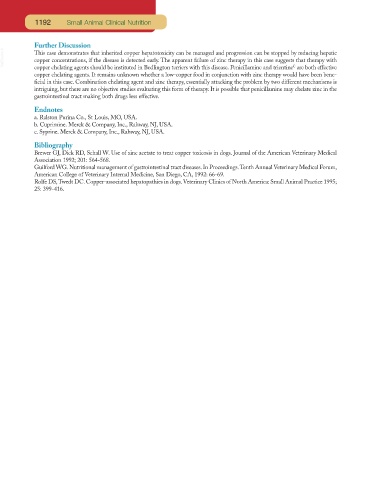Page 1146 - Small Animal Clinical Nutrition 5th Edition
P. 1146
1192 Small Animal Clinical Nutrition
Further Discussion
VetBooks.ir This case demonstrates that inherited copper hepatotoxicity can be managed and progression can be stopped by reducing hepatic
copper concentrations, if the disease is detected early. The apparent failure of zinc therapy in this case suggests that therapy with
c
copper chelating agents should be instituted in Bedlington terriers with this disease. Penicillamine and trientine are both effective
copper chelating agents. It remains unknown whether a low-copper food in conjunction with zinc therapy would have been bene-
ficial in this case. Combination chelating agent and zinc therapy, essentially attacking the problem by two different mechanisms is
intriguing, but there are no objective studies evaluating this form of therapy. It is possible that penicillamine may chelate zinc in the
gastrointestinal tract making both drugs less effective.
Endnotes
a. Ralston Purina Co., St Louis, MO, USA.
b. Cuprimine. Merck & Company, Inc., Rahway, NJ, USA.
c. Syprine. Merck & Company, Inc., Rahway, NJ, USA.
Bibliography
Brewer GJ, Dick RD, Schall W. Use of zinc acetate to treat copper toxicosis in dogs. Journal of the American Veterinary Medical
Association 1992; 201: 564-568.
Guilford WG. Nutritional management of gastrointestinal tract diseases. In Proceedings.Tenth Annual Veterinary Medical Forum,
American College of Veterinary Internal Medicine, San Diego, CA, 1992: 66-69.
Rolfe DS,Twedt DC. Copper-associated hepatopathies in dogs.Veterinary Clinics of North America: Small Animal Practice 1995;
25: 399-416.

